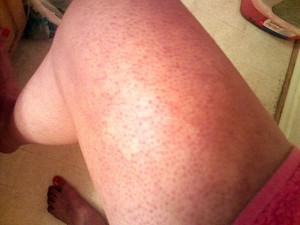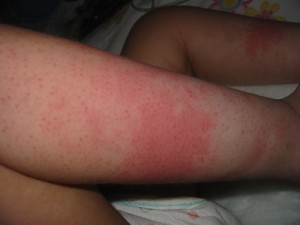Although the most common location that keratosis pilaris is generally found is on the upper arms, KP does often spread to the lower arms, back, chest, buttocks and the legs. In fact, you can potentially get KP outbreaks on all areas of the body except for the palms of the hands the the soles of your feet.
Many keratosis pilaris patients complaint of having KP outbreaks that appear on their legs, most commonly the thighs, but also on the lower legs as well. When KP appears on the legs, typically the bumps get larger and the overall redness that’s seen on the skin tends to cover a larger area. Also, discoloration that frequently occurs with cases of severe keratosis pilaris outbreaks is more common among people with KP on their legs, even if they’re not experiencing a case of severe or extreme keratosis pilaris.

Many patients who suffer from KP on their legs will also have keratosis pilaris show up on their buttocks at some point in their lives. If you’re not currently involved in, researching or seeking treatment for your KP, at least the keratosis pilaris bumps and redness are normally much easier to cover up or hide if it’s showing up on your legs.

If you’re actively looking to treat the KP on your legs, there are many different treatment options available to you. It’s important to understand that, unlike many other types of skin conditions, keratosis pilaris has no 100% clinically proven working treatment (that works for all people).
There are many different treatment routines, many work great for some people, but not for all. You should definitely be following some of the basics of clearing up the KP bumps and redness on your skin, for instance:
1 – Exfoliate your legs at least twice per day using a loofah
and a quality exfoliating scrub.
Some people have reported great improvement in their skin by doing one of each, a wet and dry exfoliation per day. A wet exfoliation in the shower or bath and one dry exfoliation (Using a designated dry loofah and not using exfoliating scrub).
2 – Apply a high quality moisturizer to the affected areas of your legs at least twice a day.
3 – Wash your legs with a KP friendly soap once or twice per day.
4 – Try to avoid temperatures that are too hot (causing the skin on your legs to sweat or dry out) or too cold, both have been known to ‘aggravate’ keratosis pilaris.
You may also want to look into possibly changing your diet and limiting your direct exposure to the sun, among other things.
Recently, an all natural treatment for keratosis pilaris has been getting a lot of national media attention. Many people are attributing their being KP free to this new system, which uses commonly available ingredients that can be bought at any grocery store. You can learn more about it here.